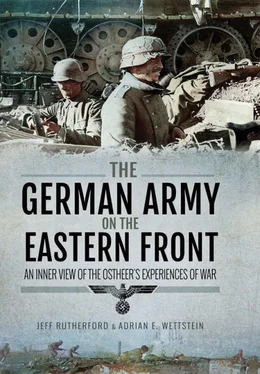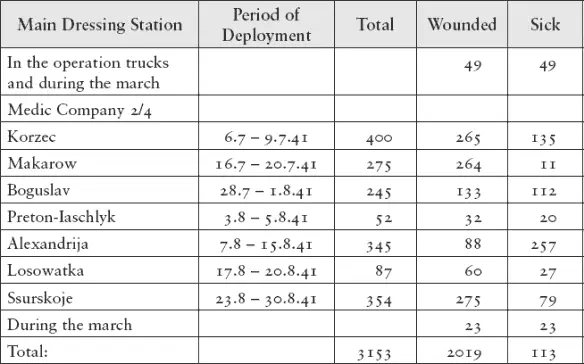[…]
18) Losses
Material: Aircraft: Total losses: 1 Ju 87, 4 Fw 189, 1 Ju 52, 6 DFS 230, 6 Bf 109, 11 Go 242, 17 He 111, 1 FW 190 = 47 aircraft
[…]
Crashes 60-100%: 2 Ju 87, 3 He 111, 2 Bf 109, 1 HS 126 = 8 aircraft
[…]
Crashes below 60%: 3 Ju 87, 19 He 111, 3 Bf 109, 1 DFS 230 = 26 aircraft [27]
Total losses of aircraft from 25.11.42-15.1.43: 81 aircraft
19) Personnel losses:
A) Flying personnel: […] 17 officers, 133 NCOs and men
The small target areas were the main issue, a problem that had already been under discussion in winter 1941. Soviet fire concentrated over such small target areas made air drops nearly impossible and caused heavy losses. Tests with Stuka s failed to achieve a positive result and the problem was never solved by the Luftwaffe. One possible solution – if the target area was not too small – was the use of gliders. As mentioned in the report, this solution led to a host of new problems. The training of glider pilots, who were often lost in the operations as few strongpoints were relieved, was demanding. Once again, a lack of resources was compensated for by a man’s commitment and courage.
The source also mentioned the constant dilemma of the command: how to divide its aircraft between the two tasks of supporting ground forces and supplying the encircled troops. In the case of the operations in Velikiye Luki, this became more pressing, when from late December on, German relief actions were in need of all available air support, while at the same time supply stocks in the city were depleted. On a strategic level, the lack of adequately trained crews and the demands for multiple air-supply operations led to trainer crews from flight schools flying supply missions at the front, which had an adverse effect both on the quantity of trained pilots and on the quality of their training. This was a decisive factor in the weakening of the Luftwaffe in 1942/43. [28]
Another interesting aspect of the air force report was its overwhelmingly positive tone. While the army recognized the air force’s achievements, its final note on the air supply was much more sober and less heroic: [29]
Experience: Despite all efforts of the aircraft crews involved, the air supply of Velikiye Luki was not enough to provide the garrison with the necessary weapons and ammunition, food and medical supplies for the purpose of carrying out the fight. At the time when the dimensions of the strongpoint would have permitted a major deployment of supply aircraft and gliders, this could not be carried out due to bad weather. When the weather permitted the deployment of the Luftwaffe, the strongpoint had been so narrowed by break-ins and breakthroughs that the bulk of the aerial delivery units dropped had drifted to the enemy’s side or could not be recovered because of heavy enemy fire. The enemy’s strong anti-aircraft and fighter defence forced air drops from high altitudes. When the garrison had been compressed into individual strongpoints, which were no longer connected, it was therefore attempted to drop supply containers without parachutes from Stuka s. The contents, however, were for the most part destroyed on impact.
Also interesting – especially when considering the wide variety of goods required – is the final list of supplies flown into Velikye Luki: [30]
Final summary of supplies, weapons, etc., transported to Velikiye Luki by air, between 29.11.42 and 7.1.43
Ammunition: 164.332 tons
Rations: 5.248 tons and 7.500 rations of tobacco Fuel: 0.33cbm
MG oil: 0.05cbm
Anode battery: 290 pieces
Flashlight battery: 500 pieces
Flashlights: 650 pieces, plus 50 flashlight bulbs Bulbs: 50 pieces
Radio equipment: 2 B1 and 2 D
Heavy field cable: 20km
Electrical tape: 100 rolls
Vacuum Tubes RV 2 / P 800: 20 pieces Field handset: 4 pieces
Accumulators: 2 units
Medical material: 3.25 tons, including 1 amputation and 1 surgeon’s kit
Mail
Iron crosses: 4 packages
Light mortars: 6
Heavy mortars: 4
MG 42 with accessories: 10
MG 34: 8
Heavy machine gun 34: 4
7.5cm Pak: 4 (including crew)
Telescopic sights for 4.5cm Pak (r): 2 Spare parts for MG 34 […]
Spare parts for MG 26 (t) […]
2 packs with cold-resistant grooved ring collars for heavy field howitzer and heavy 10cm guns 18.
1 battery-locksmith case
[With cargo-carrying gliders]: 1 engineer assault group (15 men)
As already seen, the supply item delivered in the greatest quantity was ammunition. In order to keep the troops fighting, replacement weapons, rations and fuel were of course also required. Medical supplies were much more an issue of morale than of actual combat need, as were letters from home. Also flown in were special weapons, such as the powerful 7.5cm ATG and engineer assault groups with flamethrowers, especially effective in urban warfare. To maintain communication with the outside and to influence and perhaps even manipulate the garrison, radio sets and everything needed to operate them, such as accumulators and tubes, were also brought into the city. Seemingly minor items such as flashlights had to be flown in, as they were essential for patrols on long winter nights so the Germans could maintain control over the frontline. So too were cold-resistant spare parts for guns and tools for gun maintenance. We have only a few indications of how much of the previously mentioned goods actually reached the encircled garrison.
While air supply was helpful in some special situations, it often proved a waste of resources. It required a sizeable infrastructure and high-quality personnel to work, and the losses in men and material were high, especially considering the relatively small amount of supplies delivered (and actually received). Even worse was the fact that the successful operations in winter 1941/42 awakened unrealistic expectation about the possibilities of supplying encircled forces of any size for long periods. This resulted in a sanguine attitude towards encirclements at the highest German command levels that was as essential for developments on the Eastern front in 1944 as Hitler’s ill-fated orders on fortresses and holding positions.
Medical services were essential in keeping the German Ostheer fighting. [31]Determined Soviet resistance, as well as the sheer size of the Red Army, caused German losses to rise to levels far higher than in previous campaigns. This placed a heavy burden on medical units right from the beginning, as the following source of the 14th Panzer Division, fighting in Panzer Group 1 on the German southern wing, illustrates: [32]
During the campaign in Russia, altogether 3,153 soldiers were treated by the medical service of the 14th Panzer Division in the time period from 22.6.until 31.8.1941. Of these, 2,019 were wounded and 1,134 were sick.
Specifically, the cases were distributed among the medic companies or the clearing station:
Four surgeons of the companies, who with the operation assistants in almost uninterrupted work during their particular deployment, bore the brunt in caring for the wounded, are especially deserving of recognition.
The ambulance platoons 1/4, 2/4 and 3/4 covered altogether 109,000km during the transport of the wounded from the front line to the main dressing stations or to the main dressing stations in the medical installations lying in the rear areas, sometimes under enemy fire and thereby transporting 2,928 wounded and sick.
Читать дальше








![John Stieber - Against the Odds - Survival on the Russian Front 1944-1945 [2nd Edition]](/books/405234/john-stieber-against-the-odds-survival-on-the-russian-front-1944-1945-2nd-edition-thumb.webp)





